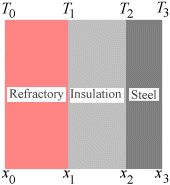Heat Transfer Problem :
Minimum thickness for a composite furnace wall
Problem.
The wall of a furnace comprises three layers as shown in the figure. The first layer is refractory (whose maximum allowable temperature is 1400oC) while the second layer is insulation (whose maximum allowable temperature is 1093oC). The third layer is a plate of 6.35 mm thickness of steel [thermal conductivity = 45 W/(m K)]. Assume the layers to be in very good thermal contact.

Figure. Layers in a composite furnace wall.
The temperature T0 on the inside of the refractory is 1370oC, while the temperature T3 on the outside of the steel plate is 37.8oC. The heat loss through the furnace wall is expected to be 15800 W/m2. Determine the thickness of refractory and insulation that results in the minimum total thickness of the wall.
Given thermal conductivities in W/(m K):
| Layer | k at 37.8oC | k at 1093oC |
| Refractory | 3.12 | 6.23 |
| Insulation | 1.56 | 3.12 |
Solution.
In general, the heat flow is given by Q = ![]() T/Rth and
the thermal resistance for a rectangular slab is Rth =
T/Rth and
the thermal resistance for a rectangular slab is Rth = ![]() x/(kA), where
x/(kA), where ![]() T is the temperature driving force (thermal potential difference),
T is the temperature driving force (thermal potential difference), ![]() x is the slab thickness, k is the thermal conductivity, and A is the cross-sectional area of the slab.
x is the slab thickness, k is the thermal conductivity, and A is the cross-sectional area of the slab.
The thermal resistances for the three layers are in series as shown in the figure below.
Figure. Thermal resistance representation of composite furnace wall.
Based on the thermal resistance representation for the composite furnace wall, the heat flux q is
| (1) |
In the refractory and insulation, the thermal conductivity k varies with temperature. If a linear variation is assumed, then the arithmetic mean is to be used for the thermal conductivity.